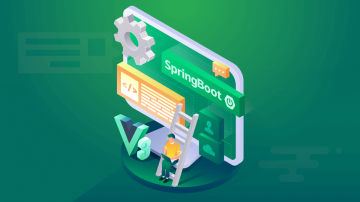本文提供了Spring Boot的详细介绍,包括其优势、环境搭建和基本应用开发。文章还涵盖了Spring Boot的核心概念、常用功能以及项目实战和部署方法。通过本文,读者可以快速掌握Spring Boot的基本使用方法并应用于实际开发中。
Spring Boot 简介什么是Spring Boot
Spring Boot 是由Pivotal团队提供的一个基于Spring平台的快速开发框架。它通过自动配置功能简化了应用开发、依赖管理和部署流程,使得开发者可以更加专注于业务逻辑的实现,而不是框架的配置。Spring Boot的核心目标是简化Spring应用的开发和部署,使得开发者可以快速构建独立运行的、生产级别的应用。
Spring Boot的优势
- 自动配置:Spring Boot通过约定大于配置的思想自动配置应用程序,减少配置文件的编写工作。
- 独立运行:可以方便地将Spring Boot应用打包为独立的war或jar包,其中包含了运行应用所需的所有依赖库。
- 无依赖配置:引入了
Spring Boot Starter的概念,通过一个starter就可以引入所有需要的依赖,极大简化了依赖管理。 - 无需XML配置:几乎所有的配置都可以通过注解或属性配置来完成,不需要编写大量的XML配置文件。
- 内嵌Web服务器:Spring Boot支持内嵌的Web服务器,如Tomcat、Jetty或Undertow,可以不借助外部容器直接运行应用。
Spring Boot的环境搭建
- 安装Java环境:确保已经安装了Java开发工具包(JDK),建议使用JDK 8或更高版本。
- 安装Maven或Gradle:Spring Boot支持使用Maven或Gradle构建项目。
- 安装IDE:推荐使用IntelliJ IDEA或Eclipse,它们都提供了Spring Boot的相关插件支持。
- 安装STS(Spring Tool Suite):STS是一个专门为Spring开发者设计的IDE,提供了许多便利的功能,如快速创建Spring Boot项目、自动配置等。
使用Spring Initializr创建项目
Spring Initializr是一个在线的项目生成器,可以通过指定项目的一些基本信息来生成Spring Boot项目。以下是具体步骤:
- 访问Spring Initializr官网:https://start.spring.io/
- 选择项目的基本信息,如语言(Java)、版本(Java 11)、项目类型(Maven项目)、依赖(Spring Web、Spring Data JPA等)、依赖管理(Spring Boot版本)。
- 点击“生成项目”按钮,下载生成的项目压缩包。
- 解压下载的压缩包,并导入到IDE中,如IntelliJ IDEA或Eclipse。
<!-- pom.xml -->
<project xmlns="http://maven.apache.org/POM/4.0.0"
xmlns:xsi="http://www.w3.org/2001/XMLSchema-instance"
xsi:schemaLocation="http://maven.apache.org/POM/4.0.0 http://maven.apache.org/xsd/maven-4.0.0.xsd">
<modelVersion>4.0.0</modelVersion>
<groupId>com.example</groupId>
<artifactId>demo</artifactId>
<version>0.0.1-SNAPSHOT</version>
<parent>
<groupId>org.springframework.boot</groupId>
<artifactId>spring-boot-starter-parent</artifactId>
<version>2.3.1.RELEASE</version>
</parent>
<dependencies>
<dependency>
<groupId>org.springframework.boot</groupId>
<artifactId>spring-boot-starter-web</artifactId>
</dependency>
</dependencies>
<build>
<plugins>
<plugin>
<groupId>org.springframework.boot</groupId>
<artifactId>spring-boot-maven-plugin</artifactId>
</plugin>
</build>
</project>添加依赖
示例中,使用了Spring Boot Starter Web依赖,这是一个包含所有必要的依赖的Spring Web应用的starter。它包括Spring Web MVC和一个Tomcat内嵌服务器,使得应用可以直接运行。
<dependencies>
<dependency>
<groupId>org.springframework.boot</groupId>
<artifactId>spring-boot-starter-web</artifactId>
</dependency>
</dependencies>编写第一个控制器
创建一个简单的Spring Boot控制器来响应HTTP请求。在这个例子中,创建一个名为HelloController的类,使用@RestController注解来标识这个类是一个控制器,并使用@RequestMapping注解指定URL路径。
import org.springframework.web.bind.annotation.GetMapping;
import org.springframework.web.bind.annotation.RestController;
@RestController
public class HelloController {
@GetMapping("/hello")
public String hello() {
return "Hello World!";
}
}在src/main/java/com/example/demo/HelloController.java中编写控制器代码。运行应用后,可以访问http://localhost:8080/hello来查看结果。
自动配置
Spring Boot通过自动配置机制来简化配置工作。自动配置的主要目的是根据类路径中的jar包和一些默认设置来自动配置应用。例如,如果spring-boot-starter-web在项目的依赖中,那么Spring Boot会默认配置一个Tomcat服务器,并且会自动配置Spring MVC。
Starter依赖
Starter依赖是Spring Boot的核心概念之一,它是一个包含许多依赖的特殊依赖,这样可以简化开发人员的工作,避免手动添加大量的依赖。例如,spring-boot-starter-web包含了构建Web应用所需的所有依赖。
<dependency>
<groupId>org.springframework.boot</groupId>
<artifactId>spring-boot-starter-web</artifactId>
</dependency>Actuator监控
Spring Boot Actuator提供了许多生产中需要的特性,如健康检查、审计、信息端点等。可以通过注册一些额外的依赖来启用这些特性,如spring-boot-starter-actuator。
<dependency>
<groupId>org.springframework.boot</groupId>
<artifactId>spring-boot-starter-actuator</artifactId>
</dependency>启用后,可以访问http://localhost:8080/actuator来查看应用的各种信息端点。
配置文件详解
Spring Boot使用application.properties或application.yml作为配置文件。这些文件可以位于src/main/resources目录下。默认情况下,Spring Boot会自动读取这些配置文件,并根据其中的配置来启动应用。配置文件可以包含各种配置属性,如数据库连接、服务器端口等。
# application.properties
server.port=8080
spring.datasource.url=jdbc:mysql://localhost:3306/test
spring.datasource.username=root
spring.datasource.password=secret
spring.datasource.driver-class-name=com.mysql.jdbc.Driver数据库集成
Spring Boot支持多种数据库,包括MySQL、PostgreSQL、SQLite等。要集成数据库,可以通过添加相应的starter依赖,并配置数据库的连接信息。
示例代码中,整合MySQL数据库。
<dependency>
<groupId>org.springframework.boot</groupId>
<artifactId>spring-boot-starter-data-jpa</artifactId>
</dependency>
<dependency>
<groupId>mysql</groupId>
<artifactId>mysql-connector-java</artifactId>
</dependency>在配置文件中指定数据库连接信息。
spring.datasource.url=jdbc:mysql://localhost:3306/test
spring.datasource.username=root
spring.datasource.password=secret
spring.jpa.hibernate.ddl-auto=update以下是一个简单的数据库操作示例,创建一个用户表,并插入数据:
import org.springframework.boot.CommandLineRunner;
import org.springframework.boot.SpringApplication;
import org.springframework.boot.autoconfigure.SpringBootApplication;
import org.springframework.jdbc.core.JdbcTemplate;
import javax.annotation.Resource;
@SpringBootApplication
public class DatabaseIntegrationExample implements CommandLineRunner {
@Resource
private JdbcTemplate jdbcTemplate;
public static void main(String[] args) {
SpringApplication.run(DatabaseIntegrationExample.class, args);
}
@Override
public void run(String... args) throws Exception {
jdbcTemplate.execute("CREATE TABLE users (id INT, name VARCHAR(255))");
jdbcTemplate.execute("INSERT INTO users (id, name) VALUES (1, 'John Doe')");
jdbcTemplate.execute("INSERT INTO users (id, name) VALUES (2, 'Jane Doe')");
}
}日志管理
Spring Boot集成了常见的日志框架,如Logback、Log4j等。默认情况下,使用Logback作为日志框架。可以通过logging.level属性来设置不同包的日志级别。
# application.properties
logging.level.root=INFO
logging.level.com.example=DEBUG构建RESTful API
构建RESTful API通常需要定义一些资源和操作这些资源的HTTP方法。例如,可以创建一个UserController来处理用户相关的操作。
import org.springframework.web.bind.annotation.*;
import java.util.HashMap;
import java.util.Map;
@RestController
public class UserController {
private Map<Integer, User> users = new HashMap<>();
@PostMapping("/users")
public User createUser(@RequestBody User user) {
users.put(user.getId(), user);
return user;
}
@GetMapping("/users/{id}")
public User getUserById(@PathVariable int id) {
return users.get(id);
}
@PutMapping("/users/{id}")
public User updateUser(@PathVariable int id, @RequestBody User updatedUser) {
users.put(id, updatedUser);
return updatedUser;
}
@DeleteMapping("/users/{id}")
public void deleteUser(@PathVariable int id) {
users.remove(id);
}
}文件上传与下载
可以使用Spring Boot的CommonsMultipartResolver来处理文件上传和下载。
import org.springframework.core.io.Resource;
import org.springframework.core.io.UrlResource;
import org.springframework.http.ResponseEntity;
import org.springframework.web.bind.annotation.*;
import org.springframework.web.multipart.MultipartFile;
import java.io.IOException;
import java.nio.file.Files;
import java.nio.file.Path;
import java.nio.file.Paths;
@RestController
public class FileController {
private static final Path rootLocation = Paths.get("upload-dir");
@PostMapping("/upload")
public String handleFileUpload(@RequestParam("file") MultipartFile file) {
try {
Files.copy(file.getInputStream(), rootLocation.resolve(file.getOriginalFilename()));
return "You successfully uploaded " + file.getOriginalFilename() + "!";
} catch (IOException e) {
e.printStackTrace();
return "FAIL!";
}
}
@GetMapping("/files/{filename:.+}")
public ResponseEntity<Resource> serveFile(@PathVariable String filename) {
Path file = rootLocation.resolve(filename);
Resource resource = new UrlResource(file.toUri());
HttpHeaders headers = new HttpHeaders();
headers.add("Cache-Control", "no-cache, no-store, must-revalidate");
headers.add("Pragma", "no-cache");
headers.add("Expires", "0");
headers.add("Content-Type", Files.probeContentType(file));
return ResponseEntity.ok().headers(headers).body(resource);
}
}异常处理
在Spring Boot中,可以通过创建一个全局异常处理器来集中处理应用中的各种异常。
import org.springframework.http.HttpStatus;
import org.springframework.http.ResponseEntity;
import org.springframework.web.bind.annotation.ControllerAdvice;
import org.springframework.web.bind.annotation.ExceptionHandler;
import org.springframework.web.bind.annotation.ResponseBody;
import org.springframework.web.bind.annotation.ResponseStatus;
@ControllerAdvice
public class GlobalExceptionHandler {
@ExceptionHandler(ResourceNotFoundException.class)
@ResponseBody
@ResponseStatus(HttpStatus.NOT_FOUND)
public String handleResourceNotFoundException(ResourceNotFoundException ex) {
return ex.getMessage();
}
@ExceptionHandler(Exception.class)
@ResponseBody
@ResponseStatus(HttpStatus.INTERNAL_SERVER_ERROR)
public String handleGeneralException(Exception ex) {
return "Internal server error";
}
}文件上传与下载资源类定义
import org.springframework.core.io.Resource;
import org.springframework.core.io.UrlResource;
import org.springframework.stereotype.Service;
import org.springframework.util.FileSystemUtils;
import org.springframework.web.multipart.MultipartFile;
import java.io.IOException;
import java.io.InputStream;
import java.net.MalformedURLException;
import java.nio.file.Files;
import java.nio.file.Path;
import java.nio.file.Paths;
import java.nio.file.StandardCopyOption;
@Service
public class FileStorageService {
public static final String UPLOAD_DIR = "upload-dir";
public void init() {
FileSystemUtils.deleteRecursively(Paths.get(UPLOAD_DIR).toFile());
Files.createDirectory(Paths.get(UPLOAD_DIR));
}
public void storeFile(MultipartFile file) {
try (InputStream inputStream = file.getInputStream()) {
Files.copy(inputStream, Paths.get(UPLOAD_DIR, file.getOriginalFilename()), StandardCopyOption.REPLACE_EXISTING);
} catch (IOException e) {
e.printStackTrace();
}
}
public Resource loadFileAsResource(String filename) throws MalformedURLException {
Path fileStorageLocation = Paths.get(UPLOAD_DIR).toAbsolutePath().normalize();
Path filePath = fileStorageLocation.resolve(filename).normalize();
Resource resource = new UrlResource(filePath.toUri());
if (resource.exists()) {
return resource;
} else {
throw new RuntimeException("File not found " + filename);
}
}
}打包与发布
使用Maven或Gradle可以将项目打包为jar或war包。例如,使用Maven打包项目:
mvn clean package生成的jar或war包位于target目录下。
部署到Tomcat
可以将生成的war包直接部署到Tomcat服务器。将war包复制到Tomcat的webapps目录下,然后启动Tomcat服务器即可。
部署到Docker
可以使用Docker来部署Spring Boot应用。首先构建一个包含应用的Docker镜像,然后使用该镜像来启动容器。
# Dockerfile
FROM openjdk:8-jdk-alpine
VOLUME /tmp
ADD target/*.jar app.jar
ENTRYPOINT ["java","-jar","/app.jar"]构建并运行Docker镜像:
docker build -t my-spring-boot-app .
docker run -p 8080:8080 my-spring-boot-app以上是Spring Boot入门与初级使用教程的全部内容,希望能够帮助读者快速掌握Spring Boot的基本使用方法和一些高级特性。

 随时随地看视频
随时随地看视频




